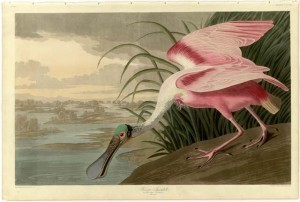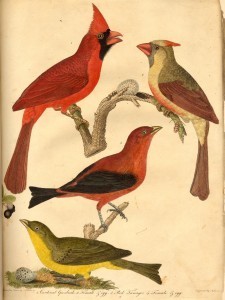The Bird is the Word

Roseate Spoonbill from “The Birds of America.” 1836. Rare Book & Special Collections Division.
“Bird” has been the word around my house lately. And, today, we celebrate Bird Day – a holiday established in 1894 by Charles Almanzo Babcock, a school superintendent in Oil City, Penn. Babcock hoped the initiative would promote conservation and awareness to the public, especially school children.
Recently, a friend of mine started talking about “The Big Year” bird-watching competition and her desire to participate. And, I’ve been enlisted to help. The informal competition takes bird watching to a whole new level, with birders vying to spot or hear the largest number of bird species within a single calendar year and within a specific geographical area. Sandy Komito holds the current record with 748 species seen in North America in a calendar year. Neither of us are really bird watchers, so things will certainly be interesting on this adventure. Fortunately, we can look to some Library of Congress resources in preparation.
Perhaps we could use as our starting point the works of John James Audubon (1785-1851), known for his famous drawings and paintings of North American birds. The first edition of his “Birds of America” book, also known as the “elephant folio,” is the largest book in the Library, at 39.37 inches high.

Cardinals with red tanager from “American Ornithology.” 1808. The Filson Historical Society.
Searching the Library’s Prints and Photographs online catalog for the title displays several lithographs from the book. In addition, a of paintings from his penultimate “Birds of America” can be found in the Library of Congress presentation “The First American West: The Ohio River Valley, 1750-1820” along with a three-volume ornithological biography with descriptions of the birds found in the book.
Another resource is the bird illustrations by painter Louis Agassiz Fuertes (1874-1927), whose work is featured in (1899) as part of the Library presentation “The Evolution of the Conservation Movement, 1850-1920.”
Scottish ornithologist Alexander Wilson (176-1813) made a comprehensive study of the birds of North America by studying the specimens skillfully mounted and displayed by artist Charles Wilson Peale and his sons in the Philadelphia Peale Museum. The museum became the repository for a wide array of natural history specimens from commercial and government-sponsored expeditions. Wilson’s masterwork, would eventually grow to nine volumes and was the first comprehensive survey published on the birds of North America.
Just as important as knowing what the birds look like is knowing when and where to actually find them. The Library’s Science, Technology and Business Division has put together a reference guide on using space-based technology like remote sensing to track bird migration.

Annual convention of the American Ornithologists’ Union held at the American Museum of Natural History, November 1935. Prints and Photographs Division.
The Library is also home to the papers of ornithologists Hans Hermann Carl Ludwig von Berlepsch (1850-1915), who was one of the first zoologists to apply Darwinian principles of systematic classification to the study of birds; Charles Bendire (1836-1897), honorary curator of the Museum of Natural History of the Smithsonian Institution; W.L. McAtee (1883-1962), an expert on the food habits of birds; and T.S. Palmer (1877-1954), former secretary of the American Ornithologist Union.
Library of Congress's Blog
- Library of Congress's profile
- 74 followers



